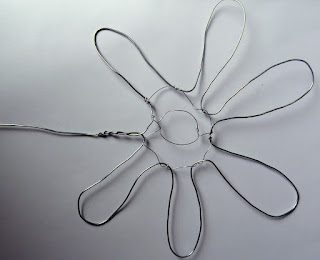Alice explained that she was making 3 installations for the Queens House, National Maritime Museum - due to be installed during the second week in March 2013.
- A portrait of Queen Henrietta Maria
- Garden of England flower installation which takes floral motifs from the clothing in the portraits of Queens and courtiers
- A hanging approx 10m high in the centre of the Tulip stairs, using the lace work from the collars and cuffs of the lacework in the displayed portraits
The Tulip staircase installation was the one she was asking for help with, the others she was creating herself. The installation uses the starting point of the tulip motif echoed in the metal banister which is a cross between a tulip and a fleur-de-lys. Also the motif of Queen Anne’s lace; which is a lacework based on the flower (which is like cow parsley). Alice explained that she needed lots of flowers to make a floating cascade in the centre of the tulip stairs.
Instructions on what to make:
- Use your initiative and be as creative and inventive as possible
- As the work is so big I can use everything and anything
- Stick carefully to a design or
- Develop and elaborate
The only things to bear in mind are:
- The main references as described
- Lace is the starting point, light airy and open, no cloth
- Don’t use too much wire as I am concerned with the overall weight
- The whole work must be white, can include little bits of black and silver
- No wool or silk to be used
Alice said that she was basing the installation on the collars, and by asking for flowers and shape contributions from everyone, she could connect and make everything into a huge piece. She intended to make the structure to which all your parts/flowers/motifs will be attached.
She enclosed pictures of how they made the lace collars. These had wire shapes which then had fabric or needle lace worked around them.
Design
This was fairly open and included any or all of the following:
- Use the wire to make individual flowers which can then be worked into with needle lace. The fleur-de-lys will echo the banisters and the other flowers are like cow parsley
- Use the design drawings attached to copy, or draw your own - each flower head up to 6cm across or smaller
- As above but make something that combines floral motifs from the various enclosed references of motifs into a bigger combined shapes - develop and let this grow
- Use the design drawings attached to copy, or draw your own each flower head not more than 6cm across
- Either draw it out or just let it grow organically
- If you don’t want to use wire, just make some floral motifs in threads - size as above.
I had never done needle-lace before, so had to Google the instructions. I found it quite fiddly, and mine wasn't very neat, but as Alice had said that anything goes I thought it would probably be OK. I only made as many pieces as I had wire for – which was 5 and then I made loom flowers with the rest of the yarn. These were very simple but I think they turned out very well. It was a bit boring doing the same thing over and over again but having seen the finished piece it was worth it.
This was a very enjoyable project to work and gave me a small insight into the work of a professional textile artist. I looked at the installation of the internet and it looks brilliant. It is a massive installation and to think it is made up of very small parts – all posted to Alice from all over the country – I think I can see some of my flowers in there!









No comments:
Post a Comment